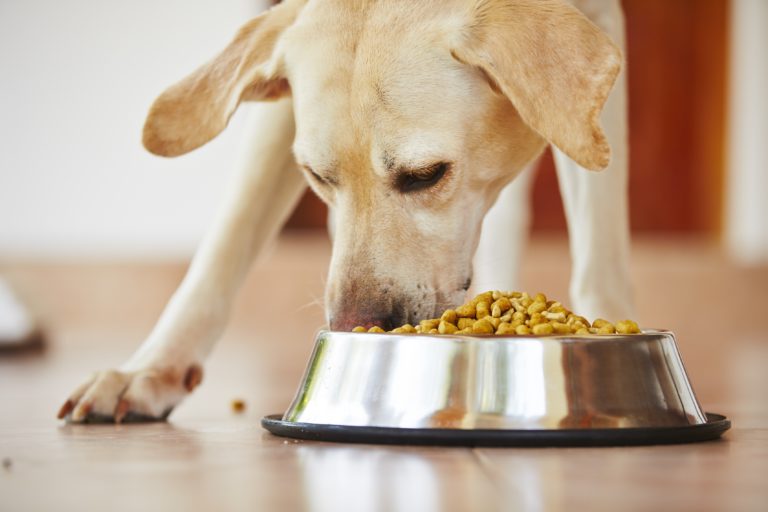Hungry labrador retriever is feeding at home.
Which is better for your dog?
First of all, the type of dog food isn’t decisive, but rather the content. This means that both wet and dry food can provide your dog with all important nutrients, vitamins and minerals, as long as the ingredients are of a high quality and the composition is right. Both types of dog food have their advantages and disadvantages, so it ultimately isn’t a question of right or wrong, but rather personal opportunities and requirements that will determine which dog food you choose in the end.
In order to make your decision a little easier, we wish to shed light on the dog food jungle out there and outline the pros and cons of different forms of food.
What are the differences between wet and dry food?
The fundamental difference between wet and dry food is primarily the different water content. Whilst dry food has a moisture content of just 3 to 12%, this is between 60 to 84% for wet food. This huge difference affects the shelf life of the food, since dry food can be kept for significantly longer than wet food, which in comparison goes off sooner.
There are also significant fluctuations between wet and dry food regarding calorie content. With dry food, dogs consume lots of calories in small quantities. In contrast, dogs must eat twice or three times as much wet food in order to reach the same calorific value. The question of which food is better for dogs’ teeth is also debatable. One side argues that the hard consistency of dry food cleans the teeth, whilst the other claims that dry food stays too firmly stuck to the teeth, which can lead to dental problems.
What are the advantages of dry food?
Due to the high energy content, dog owners only need to use small quantities of dry food to meet their dog’s needs and make sure they are full. Hence, dry food is the cheaper option. Proponents also stress that lower quantities also make it a more environmentally-friendly choice, since it uses less packaging.
A further argument in favour of dry food is that it is clean and convenient. It doesn’t have mushy spills and even if a little bit ends up outside the food bowl, it is easy to sweep up or vacuum it away. In addition, odourless dry food is easier to take away on holidays, since dogs only need smaller quantities and it’s easier to stock up on it in advance.
What are the advantages of wet food?
Whilst dry food mainly brings advantages for the owner in terms of price, cleanliness and convenience, the advantages of wet food benefit the dog itself. Most dogs would probably opt for wet food if they could choose themselves, since wet food, more intense in smell and taste, simply tastes better to them. The high water content in particular has a positive effect: since the food already provides the body with a large quantity of liquid, it’s easier to cover a dog’s fluid requirements with wet food than with dry food. Hence, wet food is particularly recommendable for dogs that don’t drink much during the day.
For dogs that have a tendency to become overweight, wet food can also be the better choice at times, provided that the cause of the excess weight is that the dog loves eating. Dogs with a substantial appetite in particular often maintain a lower weight with wet food. Due to the lower energy content per portion, they can eat a great deal without exceeding their calorie requirements.
Is a combination of wet and dry food possible?
Since both wet and dry food offer different advantages, the obvious conclusion would be that the best thing is to simply feed dogs a combination of the two. In principle there’s nothing against this, but you shouldn’t mix the two types of food and should always serve them at different times. Due to wet food’s high energy content, you should also make sure that the daily intake isn’t exceeded despite switching between wet and dry food.
When it comes to dogs that have a tendency to develop digestive problems, their owners should ideally choose just one type of food, because the to-and-fro between wet and dry food can lead to diarrhoea or constipation for sensitive stomachs. In general, combining the two types of food offers no advantages for the dog’s health, since both varieties allow it consume all vital substances. So if you’ve established that your dog likes the taste of one particular food and tolerates it well, feel free to stick with it!
The content is what matters, not the variety
The ingredients list on the packaging is more important in terms of choosing the right food for your dog than the actual variety. After all, nutrition plays a significant role in canine health. Your dog needs a high-quality food that provides everything it needs to meet its requirements and ensure healthy development. There’s no one-size-fits-all answer as to exactly what ingredients are needed. Every dog is different, therefore every dog needs different food. Individual factors like age, weight, activity level and state of health should definitely be considered when it comes to looking for the best food. In principle, a food made up of around 70% premium meat and approximately 30% vegetables as well as high-quality fats and oils is recommended for healthy adult dogs. Too much grain, preservatives, artificial flavour enhancers or even sweeteners like sugar have no place in a dog’s diet. So before you choose a variety of food, you’re best off first taking a look at the label.
